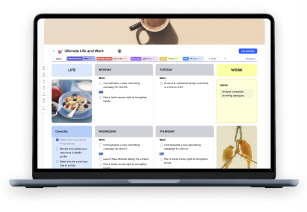Having a plan accounts for 50% of your success. A well-crafted study plan is key to achieving good results and reducing students’ stress levels. It also helps develop habits you’ll need after school, such as time management and prioritization.
This article will help you create your personal study plan. Let’s find out how a good plan can turn your study schedule into something positive and increase your grades.
What is a study plan?
A study plan is a customized schedule and strategy that outlines how, when, and what you’ll study over a certain period. It’s a time management plan tailored to your learning style, schedule, and academic goals.
The main purpose of having a study plan is to get support with overwhelming and challenging tasks students face, except for studying new material, such as managing time effectively. It helps create a structured approach to learning by breaking down big tasks into smaller chunks and coordinating study sessions with class schedules, extracurricular activities, and other commitments.
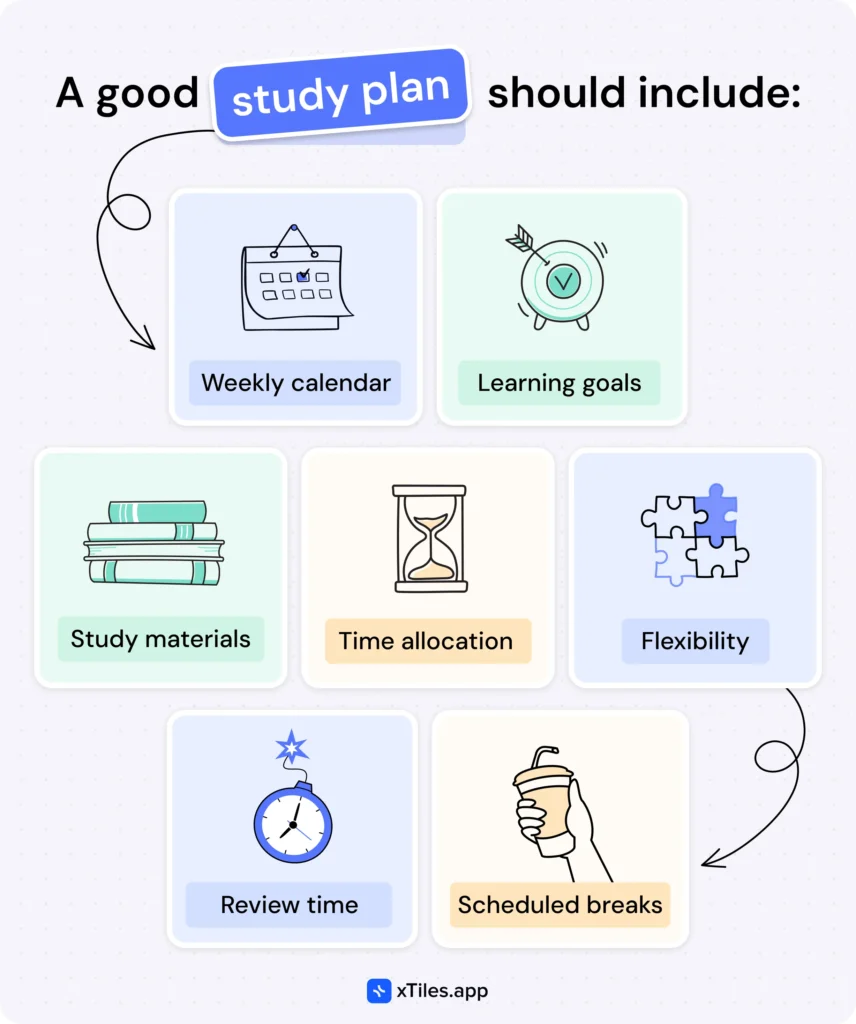
What elements should a good study plan include?
- Weekly calendar with classes, study times, and other activities
- Learning goals sections for each study session or week.
- Study materials and resources for each subject or topic.
- Time allocation for each subject is based on difficulty and importance.
- Scheduled breaks to rest and avoid burnout.
- Time to revisit and reinforce previously learned material.
- Room to adjust for unexpected events or changes in priorities.
What are the benefits of a study plan?
A study plan works in different ways. However, the list of benefits is pretty impressive, making it worth a try:
- Better time management
By scheduling study sessions, breaks, and other activities, students can make the most of their time. This structured approach means important tasks aren’t missed and prevents last-minute cramming before big exams.
- Better productivity
Students are more likely to stay focused and avoid distractions when following a study plan.
- Less stress and anxiety
When students know they’ve allocated enough time for each subject and assignment, they won’t feel overwhelmed. A good study plan also prevents the anxiety of looming deadlines by keeping steady progress toward overall goals.
- Better grades
A good study plan ensures all subjects get equal attention.
- Better long-term retention of information
By revisiting material at increasing intervals, students are more likely to move information from short-term to long-term memory.
How do you make a study plan in 8 steps?
Your study plan needs to be in some form to solidify everything you’ve planned and help you track your progress. One of the options to have it on hand at all times is the xTiles Ultimate Student Planner template, which will be a centralized hub to schedule time for all your assignments and study sessions, set goals for study and personal life, and maintain accountability.
The planner has dedicated pages to support you with learning and organizing new information. It also has an Index page to help you reach the needed spot of your planner in seconds after opening it. You can change pages and element placement to make them suit you more. You can also customize its look by adding new elements, pages, or groups of pages.
However, if you already have a planner, prefer to use a paper one, or keep everything in your head, the guide will help you as well by providing clear tips for every stage of creating an effective study plan.
1. Analyze your current study habits and routine.
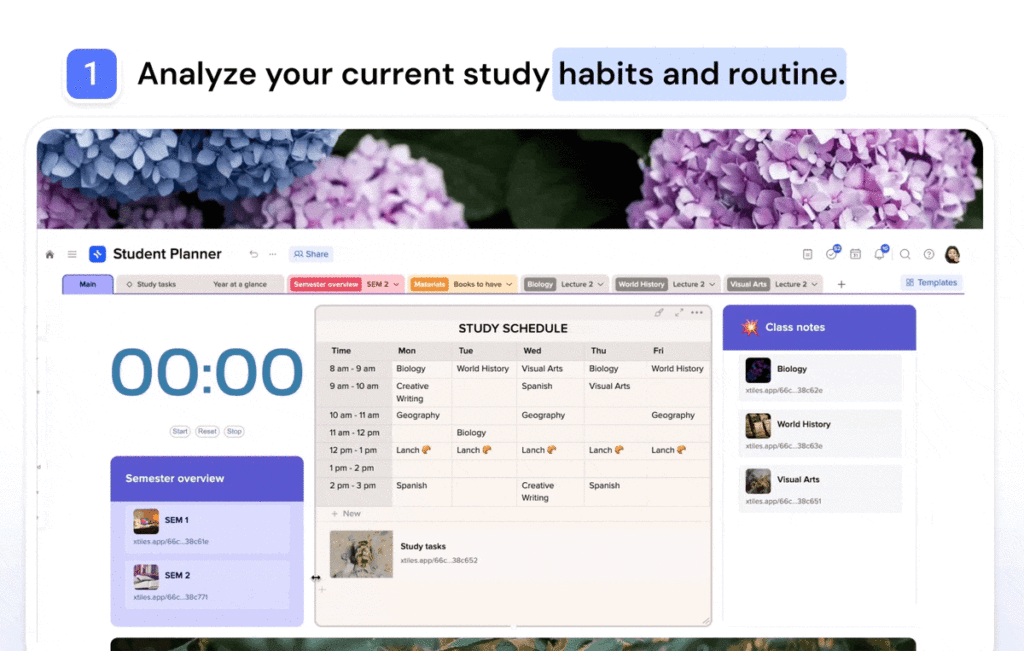
This stage is mostly about brainstorming. You can do it in the xTiles project that is going to become your study plan.
Start by looking at your current study habits and answering some questions to make a better study plan:
- What’s your learning style? Are you a visual, auditory, reading/writing, or kinesthetic learner?
- What’s your study schedule like? Do you study in long blocks or short, bite-sized chunks?
- What are your non-academic commitments, and how do they impact your study time?
- What are your challenges? Time management or focusing during long study sessions?
Write down the answers. They will be your foundation for the plan.
2. Set up your study plan for a week
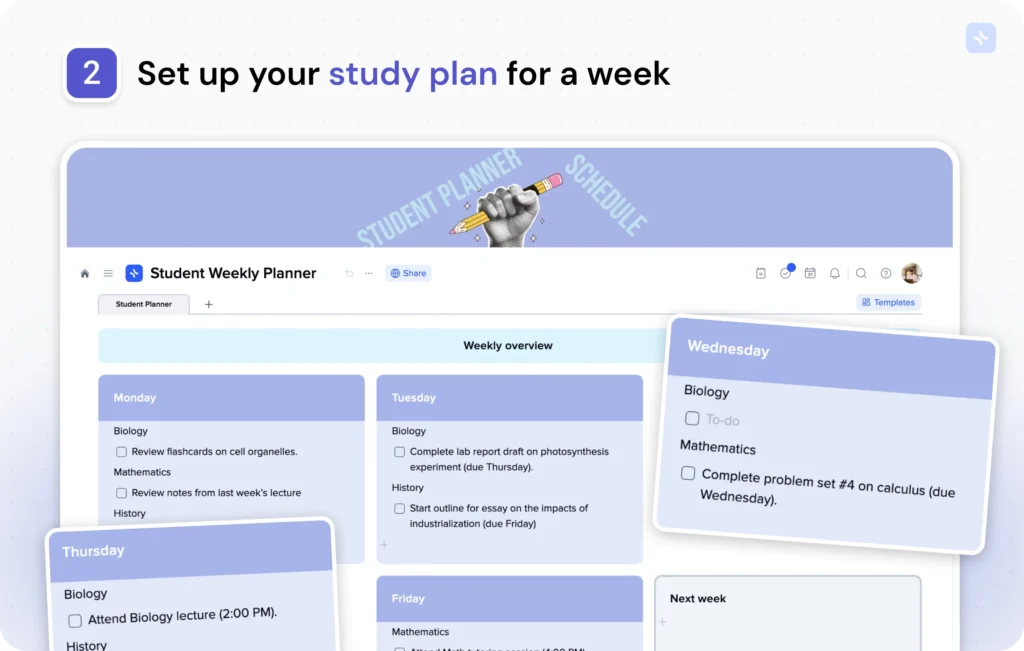
After some reflections on your study sessions, habits, and the time you spend studying, it’s time to set goals to understand what you want to reach by having a study plan. Let’s start small – weekly goals.
Start by defining your learning goals for the next 7 days. Break down your overall goals into manageable chunks, like mastering a particular skill, preparing for major exams, or completing all your work for the week. This will give your study sessions direction.
Once you have your goals set, the next thing to determine is the number of hours that you will be willing to take to study.
Take a view of your weekly schedule, the classes, activities, and all other commitments you might have in a week. What regular intervals can you spare in a day for a study session?
Given all of these, how many hours are you willing to dedicate daily toward study? In case extended periods of time are available on specific days, you can arrange for multi-hour study sessions, while shorter portions can be used for a brief check-up or study recess.
3. Prioritize your goals, subjects, and tasks
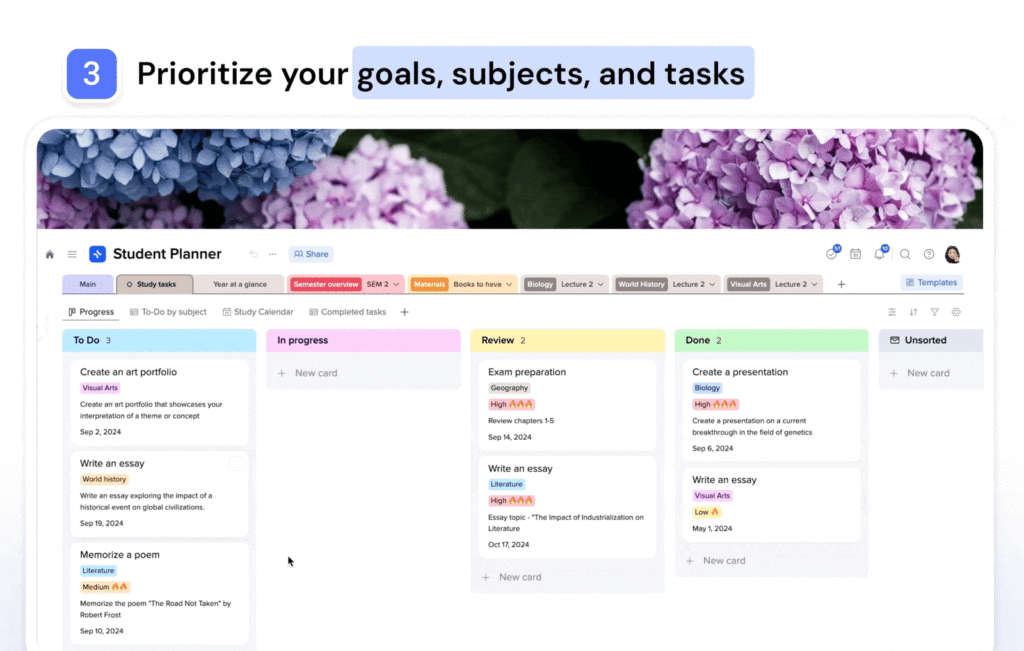
The next step is to prioritize your subjects and tasks.
First, identify the subjects that need your attention for the next few classes. Dedicate time to review the study material for these topics to get ahead. You can keep your lectures in the planner, conveniently gathered on the dedicated pages that are “built-in” into the planner’s structure so that you can save tons of information while still having a neat and clean planner.
If some subjects are tougher or need more time, prioritize them in your study plan. So you have time to understand the material fully. However, don’t focus only on one subject. Spread your study time across multiple subjects, and give each one the attention it needs while keeping in mind the study balance.
If prioritizing isn’t easy for you, you may use the Eisenhower Matrix template to decide where you need to use 100% of your focus and where you can relax a bit.
Finally, adjust as needed. Students find that priorities change as new assignments or tests come up. Be flexible with your study plan and adjust as needed to achieve your academic goals.
The planner also allows you track your personal goals to help you build your study plan according to what you want to achieve.
4. Prepare space for your lecture notes
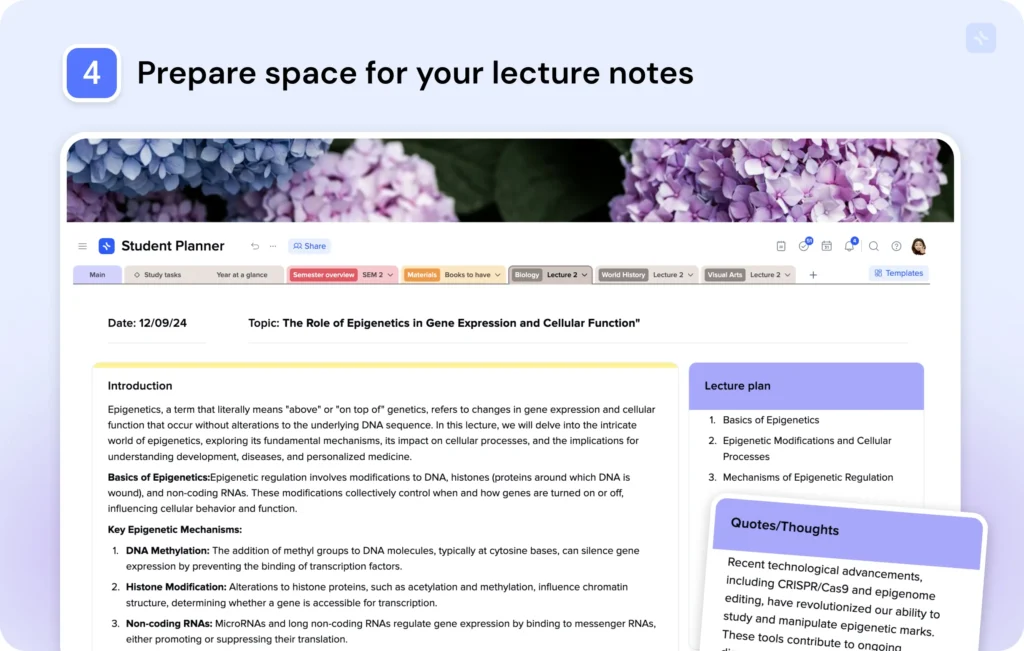
Open your courses group page and start by labeling built-in pages with the course name, date, and topic. Have your previous notes nearby. Ensure you have everything you need – add relevant links, notes, insights, etc.
It’s important to clear your space of distractions. Don’t put anything irrelevant on these pages. You will likely find a designated space for them on other planner pages. If you still need to, you can add a page or a new section. This will create a space for you to insert the information as the lecture goes on.
5. Collect your academic info
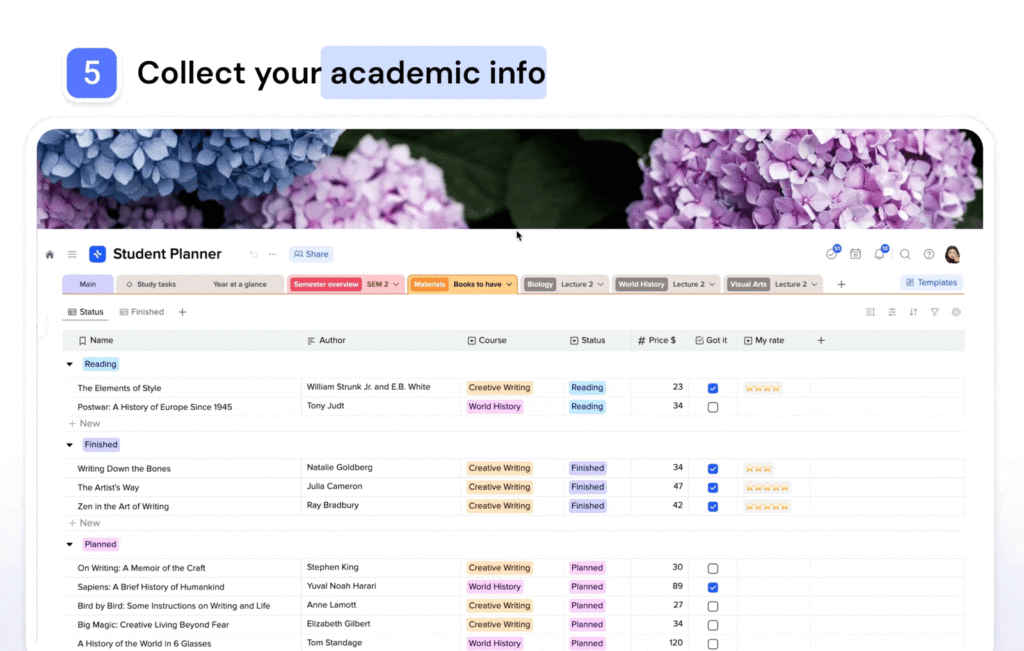
Start by gathering your reading lists for each subject, including textbooks, articles, and any other resources. Put these into a digital or physical folder so you can access them easily. Next, get your existing knowledge base, which consists of your past notes, assignments, and study guides.
Create a system to categorize this information by subject or topic. Remember to include important dates like exams, project deadlines, and paper submissions. This is your academic foundation, so you can see where you need to focus and plan your study sessions more effectively. Update this regularly so you’re always working with the most up to date resources and requirements.
6. Develop healthy habits to support your study
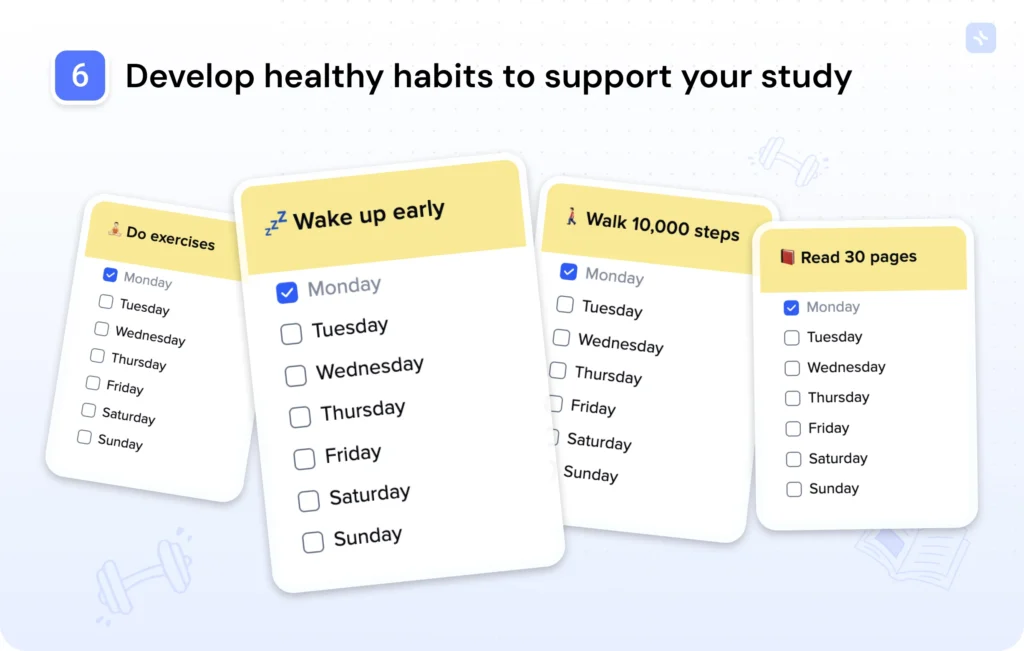
Building healthy habits is part of a good study plan. Choose habits you think you need to become more productive. However, review your habit tracker regularly to see what works for you.
By implementing your new habits gradually and tracking weekly you’ll have a holistic approach to studying that supports both your grades and overall well-being.
7. Keep track of your finances
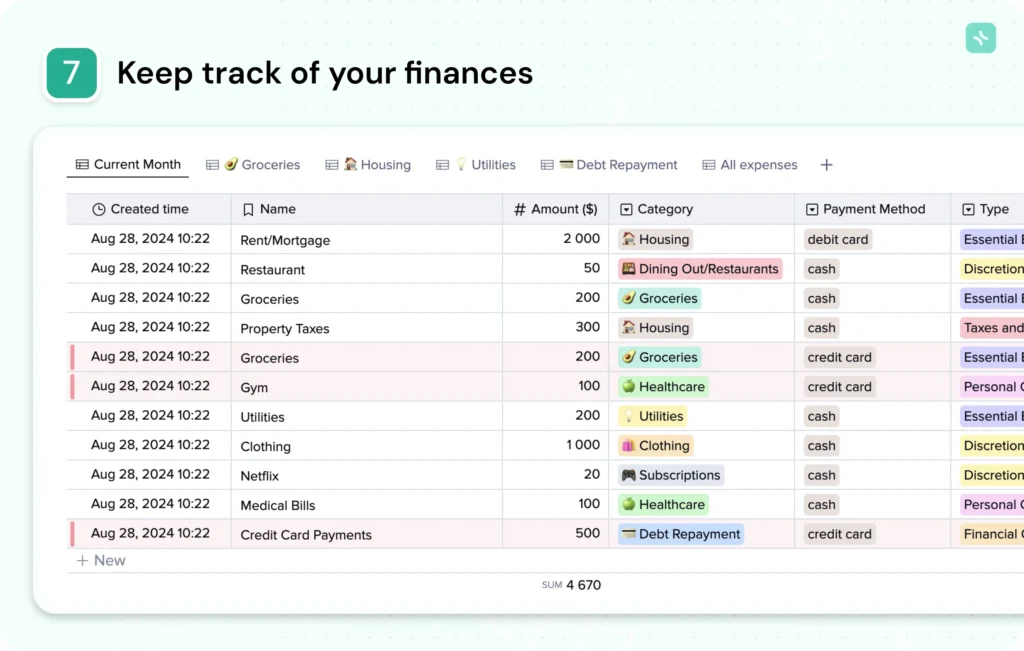
The finance planner is a key part of your study plan especially if you are managing your budget. This section helps you track and manage your education expenses so you can focus on your studies without financial stress. Start by listing all your income sources, scholarships, part time work, family support, etc. Then, categorize your expenses and essentials like tuition, textbooks, and living costs.
By having a clear overview of your finances, you can make informed decisions about work hours, course loads, and lifestyle choices that support your academic success without compromising your financial health.
8. Choose effective study techniques
Now it’s time to choose the study techniques that will help you make the most of your dedicated time.
Choose techniques that match your weekly goals. For example, if your goal is to get a chapter ahead in a subject, use techniques like summarization or mind mapping to help you quickly absorb and retain the key points. If you want to grasp new information quickly, try the Feynman Learning Method.
The planner offers the Pomodoro technique, where you break your study sessions into focused intervals followed by short breaks. You will get a timer widget for this purpose.
Adjust techniques to fit the material. Not all study techniques work for every subject. If a technique isn’t helping you achieve your weekly goals, be flexible and try a different technique that fits the material.
By choosing the right study techniques, you’ll retain more, stay on track with your study goals, and make the most of your dedicated study time.
Conclusion
Making a study plan takes time and effort. By looking at your current study habits, setting goals, managing time, prioritizing subjects, and using reliable and advanced tools, you can make a plan that helps you learn and stay organized.
The xTiles Ultimate Student Planner can become your personal studying assistant for this. It lets you schedule study sessions, track goals, manage study materials, and use techniques like the Pomodoro method all in one place. It’s flexible yet structured, so you stay on top of your academic and personal goals.
Use this and the xTiles template to make a plan that suits you and your success. Get started now with xTiles!
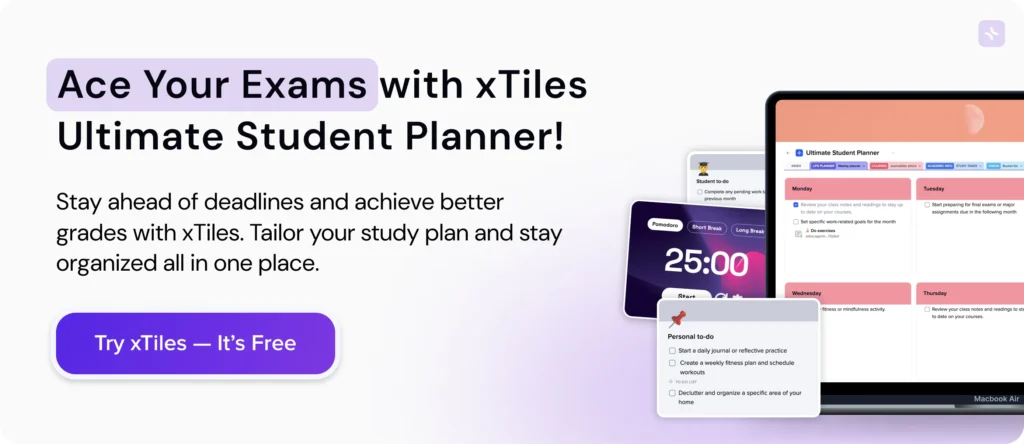
FAQ
What is a study plan for?
A study plan helps you manage your time, break down big tasks into smaller ones, and coordinate study sessions with your class schedule and other commitments. It gives you a structured way of learning, reduces stress, and increases productivity.
What should be in a good study plan?
A good study plan should have a weekly calendar with classes, study sessions, and activities, clear learning goals, study materials, time allocated to each subject, breaks, and flexibility to adjust for unexpected events.
How will a study plan help me get better grades?
By ensuring all subjects get attention, no last-minute cramming, and regular review of notes, a study plan will help long-term retention and understanding and, therefore, better results in exams and assignments.



